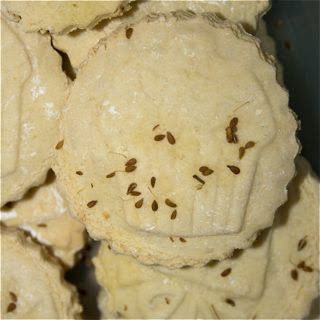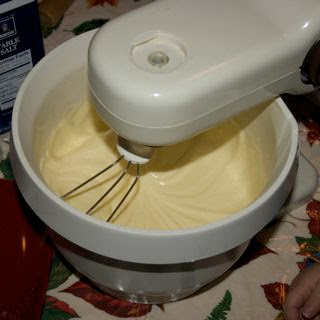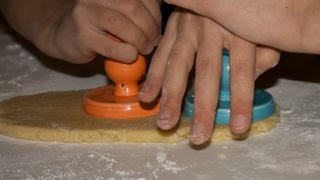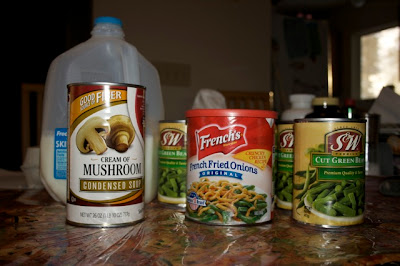
So this, our first attempt at springerle cookies, was inspired by a third grade school project. The eight-year-old had to bring in food that was important to her family and that came from a cultural group she was descendent from. Finding a food that was both turned out to be difficult for us, since there are lots of foods we grew up with that we love, but very few of them have any connection to our families’ ethnic histories. Springerle was the only thing we could think of that fit, since my husband is descended from Pennsylvania Germans and his mother made Springerle around Christmas time when he was growing up. If you want to see what more professionally made Springerle look like, try the Springerle Baker.
The recipe we’re using comes from my husband’s mother, as published in a family reunion cookbook, “A Measure of Memory.”

Springerle cookies are kind of unusual:
- They’re flavored with anise (makes them have a vague licorice taste)
- They’re molded cookies (they have a design impressed on them)
- They’re supposed to “mellow” for two weeks before eating
- 4 eggs
- 2 cups sugar
- 4 cups all-purpose flour
- 1 teaspoon baking powder
- ½ teaspeen salt
- 1 tablespoons freshly grated lemon peel
- confectioner’s sugar, for dusting pastry board
- 4 tablespoons anise seeds, to sprinkle on pans

Beat eggs in large mixer bowl at high speed until thick and lemon-colored, about 5 minutes. We have a Bosch standing mixer that we bought at a yard sale a few years ago. It’s nice to have a standing mixer for this recipe since everything needs to be beaten for so long. This is the eggs before beating:

Beat in sugar, ¼ cup at a time. Continue beating until the mixture is thick and pale, about 8 minutes. Here’s the mixture after all of this beating:

Add flour, baking powder, salt, and lemon peel. Work in with hands or wooden spoon. Gather dough in a ball, wrap, and refrigerate at least 2 hours. We did this first part one afternoon as soon as the girls got home from school on the bus, around 4 pm, and then continued with the recipe after dinner that night. Here’s what the dough ball looked like as it was being wrapped up to put in the fridge:

While the dough was in the fridge, we prepared two baking sheets by greasing them (we used non-stick spray) and sprinkling anise seeds over them. We weren’t too good at sprinkling the seeds uniformly, so we kind of spread them out with our fingers, too.

Sprinkle pastry board and plain and springerle rolling pins with confectioner’s sugar.
This brings up the part that’s really difficult: you need to find some kind of cookie mold. Springerle molds are usually fairly intricate and kind of pricey, but very pretty. We didn’t have time to search out actual springerle molds or a springerle rolling pin, so we went to the kitchen store and bought cookie molds. They probably didn’t give as pretty a cookie as springerle molds would have, but they worked.
Anyway, at this point you start to roll out the dough using confectioner’s sugar to keep it from sticking to the board and the cookie mold.
Divide dough into 3 equal parts. Roll each part ½” thick with plain rolling pin. Roll dough slowly and firmly to ¼” thickness with springerle rolling pin. Since we were using cookie molds, we rolled the dough a little bit thinner than ½”…

…and then pressed the molds into it to make the cookies about ¼” thick.

Cut cookies apart. Place 1” apart on each of 3 greased baking sheets which have been sprinkled with anise seeds. Since we had round cookie molds, we used round cookie cutters to cut out the cookies and then rolled the scraps together and rolled them out again.

We filled each cookie sheet with cookies from each third of the dough ball. The last scraps we just rolled out and placed on the cookie sheets without pressing in the cookie mold (so you could technically make springerle without using a cookie mold at all, but they wouldn’t be as pretty—and that’s part of the point). We ended up getting a dozen cookies on each tray, plus a total of 6 cookies made from the scraps. (42 cookies total)
The design on our cookie molds were a present (see below) and a cupcake.

Dry uncovered at room temperature at least 8 hours. I put the trays on top of my clothes dryer because I didn’t have any other horizontal surface that I didn’t need to use for that long. We let the cookies sit out overnight and baked them the next morning before the girls went to school.

Heat oven to 325°. Bake in center of oven until cookies are firm and light brown on bottoms, 15 to 20 minutes. Cool on wire racks.
Supposedly, one of the reasons for the name “springerle” is because the cookies “spring up” when they bake, which looks like this as they come out of the oven (if you look closely, you can see a little “foot” at the bottom of each cookie):

Reserve anise seeds remaining on baking sheets. Store cookies with reserved seeds and a slice of bread in airtight container. One of the cool things is how the cookies pick up anise seeds as they bake. This is the bottom and top of one of the cookies made from scraps to show how the anise seeds are baked into the bottoms of the cookies as they bake. The seeds are picked up by the sides in some places, too.


Change bread often. We changed the bread every two days.
Allow cookies to mellow 2 weeks. Store at room temperature no longer than 1 month. We tried the cookies the day after they were baked, and they tasted just fine then. After being stored in an airtight container for two weeks, the cookies had a drier, crunchier crust. After that, we left them in the container, but stopped keeping the bread with them. At this point, they started to really harden—the way my husband remembers really liking them. Once they were hard, I really liked them dipped in some herbal tea. Really really good.
Okay. So how’d it taste?
Flavor: Light licorice taste, but everyone in the family likes it so the licorice taste must not be too overpowering (or else my kids like licorice better than I thought).
Texture: Everyone loved it after two weeks with the bread—slightly crunchy on the outside, but still soft on the inside. My husband absolutely prefers it hard, after it’s gone without the bread for several days, but he’s alone in that.
Ease and fun: Not too easy, especially with all of the different steps, but definitely fun. The kids loved pressing the molds into the dough and cutting out the cookies.
Will we make it again? It was definitely worth the effort.
Overall grade: Win.
























